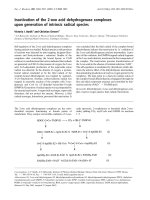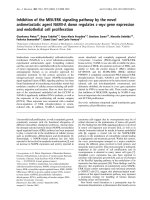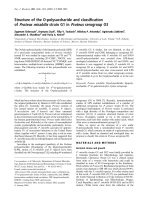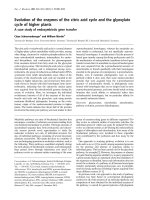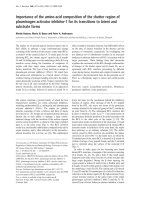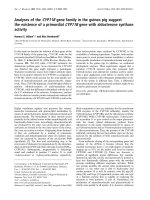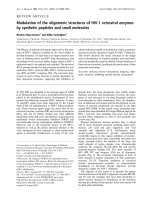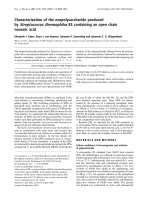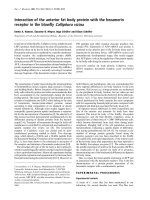Báo cáo y học: " Compression of the radial nerve at the elbow by a ganglion: two case reports" pot
Bạn đang xem bản rút gọn của tài liệu. Xem và tải ngay bản đầy đủ của tài liệu tại đây (389.99 KB, 4 trang )
Case report
Open Access
Compression of the radial nerve at the elbow by a ganglion:
two case reports
I-Ming Jou
1
, Hung-Nan Wang
2
, Ping-Hui Wang
3
, Ing-Sing Yong
4
and Wei-Ren Su
1
*
Address:
1
Department of Orthopaedic Surgery, National Cheng Kung University Hospital, Tainan 704, Taiwan,
2
Department of Nursing,
Min-Hwei College of Health Care Management, Tainan County 736, Taiwan,
3
Department of Orthopaedic Surgery, Chi-Mei Medical Center,
Tainan County 710, Taiwan and
4
Department of Orthopaedic Surgery, SinLau Hospital, Tainan, Taiwan
Email: IMJ - ; HNW - ; PHW - ; ISY - ;
WRS* -
* Corresponding author
Published: 5 June 2009 Received: 4 October 2008
Accepted: 22 January 2009
Journal of Medical Case Reports 2009, 3:7258 doi: 10.4076/1752-1947-3-7258
This article is available from: />© 2009 Jou et al; licensee Cases Network Ltd.
This is an Open Access article distributed under the terms of the Creative Commons Attribution License (
/>which permits unrestricted use, distribution, and reproduction in any medium, provided the original work is properly cited.
Abstract
Introduction: Radial nerve compression by a ganglion in the radial tunnel is not common.
Compressive neuropathies of the radial nerve in the radial tunnel can occur anywhere along the
course of the nerve and may lead to various clinical manifestations, depending on which branch is
involved. We present two unusual cases of ganglions located in the radial tunnel and requiring surgical
excision.
Case presentation: A 31-year-old woman complained of difficulty in fully extending her fingers at
the metacarpophalangeal joint for 2 weeks. Before her first visit, she had noticed a swelling and pain in
her right elbow over the anterolateral forearm. The extension muscle power of the
metacarpophalangeal joints at the fingers and the interphalangeal joint at the thumb had decreased.
Sonography and magnetic resonance imaging of the elbow revealed a cystic lesion located at the area
of the arcade of Frohse. A thin-walled ovoid cyst was found against the posterior interosseous nerve
during surgical excision. Pathological examination was compatible with a ganglion cyst. The second
case involved a 36-year-old woman complaining of numbness over the radial aspect of her hand and
wrist, but without swelling or tumor in this area. The patient had slightly decreased sensitivity in the
distribution of the sensory branch of the radial nerve. There was no muscle weakness on extension of
the fingers and wrist. Surgical exposure defined a ganglion cyst in the shoulder of the division of the
radial nerve into its superficial sensory and posterior interosseous components. There has been no
disease recurrence after following both patients for 2 years.
Conclusion: Compression of nerves by extraneural soft tissue tumors of the extremities should be
considered when a patient presents with progressive weakness or sensory changes in an extremity.
Surgical excision should be promptly performed to ensure optimal recovery from the nerve palsy.
Page 1 of 4
(page number not for citation purposes)
Introduction
Compressive neuropathies are important and widespread
debilitating clinical problems. The two most common
compressive peripheral nerve disorders in the upper limb
are carpal tunnel syndrome and cubital tunnel syndrome,
however, radial tunnel syndrome occurs less frequently
[1]. The radial tunnel is defined as the potential space
created by structures surrounding the radial nerve as well
as its posterior interosseous nerve and its superficial
sensory branch as they travel through the proximal
forearm from the radiocapitellar joint past the proximal
edge of the supinator muscle [1,2]. Compressive neuro-
pathies of the radial nerve in the radial tunnel can occur
anywhere along the course of the nerve and may lead to
various clinical manifestations, depending on which
branch is involved [3,1]. Radial nerve compression by a
ganglion in the radial tunnel is not common [4]. The
clinical features of our two cases of radial nerve compres-
sion syndrome due to a ganglion are reported, and the
anatomical characteristics of two possible compression
sites in the radial tunnel are discussed.
Case presentation
Patient 1
A 31-year-old woman complained of difficulty in fully
extending her fingers at the metacarpophalangeal joint for
2 weeks. Before her first visit, she had noticed swelling and
pain in her right elbow over the anterolateral forearm.
Examination revealed a tender swelling in the anterolateral
region of the antecubital fossa but no clinical evidence of
a mass. The extension muscle power of the metacarpo-
phalangeal joints at her fingers and the interphalangeal
joint at her thumb had decreased. The patient had full
strength with resisted wrist extension and resisted supina-
tion. The radial nerve sensibility was normal. An electro-
myogram and nerve conduction study showed early
partial neuropathy of the posterior interosseous nerve.
Sonography revealed a mass continuous with the posterior
interosseous nerve immediately distal to the radiocapitel-
lar joint. Magnetic resonance imaging (MRI) of the elbow
revealed a cystic lesion located at the area of the arcade of
Frohse, which was attached to the anterior capsule of the
radiocapitellar joint (Figure 1A, B). Due to progression of
symptoms and limitation in daily activities of the patient,
surgical excision was performed. The cyst and radial nerve
were explored through an anterolateral incision. A thin-
walled ovoid cyst, 2 × 1.5 × 0.8 cm in size, was found
against the posterior interosseous nerve just proximal to
the arcade of Frohse. The cyst was identified as a ganglion
and excised completely. The diagnosis of a ganglion was
confirmed histologically. Two years postoperatively, there
has been no evidence of recurrence and the patient has
returned to her former activities.
Patient 2
A 36-year-old, right-handed woman complained of
numbness over the radial aspect of her hand and wrist.
She complained of pain in the lateral aspect of her elbow
but did not notice swelling or tumor in this area. On
physical examination, a mass could not be definitely
detected by palpation. The patient had slightly decreased
sensitivity in the distribution of the sensory branch of the
radial nerve. There was no muscle weakness on extension
of her fingers and wrist. Electrodiagnostic studies were
consistent with the diagnosis of neuropathy of the sensory
branch of the radial nerve. Ultrasonography and MRI each
demonstrated a well-defined mass just anterior to the
radiocapitellar joint (Figure 2). Surgical exposure through
the anterolateral elbow defined a ganglion cyst in the
shoulder of the division of the radial nerve into its
superficial sensory and posterior interosseous compo-
nents. The ganglion was excised with its base. Sensory
function was completely restored within 2 months after
surgery.
Discussion
Radial nerve entrapment in the radial tunnel is uncom-
mon in peripheral nerve compressive neuropathies. There
are three different types of palsy in the radial tunnel
syndrome: posterior interosseous nerve palsy, neuropathy
of the sensory branch of the radial nerve, and neuropathy
of both nerves [1,3]. The posterior interosseous nerve is
most vulnerable to compression just beyond its origin as it
passes beneath the arcade of Frohse at the proximal edge
of the supinator in the radial tunnel [3]. Compression of
the posterior interosseous nerve alone may manifest as
Figure 1. (A) Sagittal T2W image at the level of the
radiocapitellar articulation reveals the extent and lobulated
morphology of the cystic lesion (arrows), which is located
directly anterior to the anterior aspect of the radial head.
(B) Axial, T2W image at the level of the radial head
demonstrates a lobulated cystic lesion (arrows) in the
expected area of the posterior interosseous nerve.
Page 2 of 4
(page number not for citation purposes)
Journal of Medical Case Reports 2009, 3:7258 />motor weakness in the distribution of the posterior
interosseous nerve, resulting in inability to extend the
metacarpophalangeal joints of the finger and thumb, as
well as weakness in ext ension of the thumb at the
interphalangeal joint, also called “finger drop”. Usually
there is not complete wrist drop, because the extensor
carpi radialis longus and brevis are supplied by the radial
nerve proximal to its terminal branch. Compression of the
superficial sensory branch alone may present as pain and
decreased sensation along the cutaneous area on the radial
side of the dorsum of the hand [5]. When a patient
presents with compression neuropathy of the radial nerve
below the elbow, differential diagnosis of the cause of the
palsy and further determination of the location of the
entrapment in the radial tunnel are important.
Our first case experienced lateral forearm pain that is
initially often difficult to distinguish from lateral epicondy-
litis, synovitis of the radiocapitellar joint, and a muscle tear
of the extensor carpi radialis brevis [2]. However, due to the
progressive weakness of finger extension with sparing of the
wrist extension function and the sensory of the radial nerve,
posterior interosseous nerve palsy alone was thought to be
the underlying disease. Our second case was diagnosed as
compressive neuropathy of the superficial branch of the
radial nerve, which can give rise to pain within the
distribution of the superficial radial nerve, and could
mimic de Quervain’s tendovaginitis stenosans. Our opera-
tive findings in each case revealed that a ganglion arose from
the anterior capsule of the elbow, to push up the deep or
superficial sensory branches of the radial nerve, compressing
the deep branch against the arcade of Frohse and the
superficial branch against the extensor carpi radialis muscle
(Figure 3). Yamazaki et al. reported 14 patients presenting
with posterior interosseous nerve (PIN) paralysis due to a
ganglion at the elbow, located proximal to the proximal
edge of the supinator muscle in 13 cases and distal in one
[6]. These facts suggest that there is a possibility that palsy of
either the posterior interosseous nerve or the radial sensory
branch ma y occur anywhere along the radi al tunnel
whenever a ganglion is present.
Compression of the posterior interosseous nerve by a
ganglion was first reported by Bowen in 1966 [7]. He
recorded a ganglion developed from post-traumatic osteoar-
thritic elbow secondary to an old intercondylar fracture of
the humerus. These cysts are most likely caused by repetitive
use or by inflammatory or traumatic conditions, and result
primarily from myxoid degeneration. They are associated
with increasing liquefaction of collagen fibers surrounded
by densifying collagen bundles, which form a delimiting
capsule. Other tumors can result in a space-occupying lesion
which compresses the nerve. The most common tumors
causing symptoms are rheumatic synovial cysts, lipomas,
fibromas and pseudoneuromas [7-9]. Usually, these tumors
cause paralysis with an insidious onset.
When a ganglion is not detected by palpation in cases with
palsy of the posterior interosseous nerve or sensory
branch, differential diagnosis of the cause of the palsy
Figure 2. Sonogram showing a cystic lesion reveals a 0.6 ×
0.7 × 1.8 cm hypoechoic mass that is just anterolateral to the
radial head. The cystic lesion is likely causing a mass effect
against the sensory branch of the radial nerve.
Figure 3. Diagrammatic view of the radial tunnel showing
compression of the ganglion on various locations of the
branches of the radial nerve. Arrow A indicates the
compression present in patient 1 and arrow B indicates the
compression present in patient 2.
Page 3 of 4
(page number not for citation purposes)
Journal of Medical Case Reports 2009, 3:7258 />may be difficult. Compression of nerves by extraneural
soft-tissue tumors of the extremities, although not
common, should be considered when a patient presents
with progressive weaknes s or sensory changes in an
extremity. This is true whether or not a soft-tissue mass
is found during examination, since an occult soft-tissue
tumor was found in approximately one-third of patients at
the time of operation in a report by Barber [10].
Ultrasound and MRI have been used to detect space-
occupying lesions causing nerve compression [4]. Ultra-
sound allows a detailed assessment of peripheral nerve
continuity with a mass, which indicates an intrinsic nerve
abnormality rather than an adjacent extrinsic mass.
Ultrasound has also been used to determine whether a
lesion is cyst or solid. Recent advances in MRI have
increased the ability to localize the region of the nerve
compression, and assess the tumor’srelationshipto
nearby neurovascular structures, enhancing pre-operative
planning for a precise surgical excision.
Standard surgical management for persistent neuropathy,
refractory to non-surgical treatment, is open decompres-
sion of the radial nerve. This can be done through a variety
of anterior or lateral approaches. The approach includes
addressing all of the potential sites of compression in
addition to excising the mass lesions described previously
which may cause compression of the radial nerve.
Conclusion
Radial nerve compression by a ganglion in the radial tunnel
is an uncommon condition. We report two cases of
posterior interosseous nerve and superficial sensory branch
compression by a ganglion cyst. The value of this case report
to the practicing physician is that it sheds light on the
importance of familiarity with the possible presentation,
anatomic location and differential diagnosis to facilitate
corrective diagnostic approaches and timely management.
Consent
Written in formed consent was obtained from both
patients for publication of this case report and any
accompanying images. A copy of the written consent is
available for review by the Editor-in-Chief of this journal.
Competing interest
The authors declare that they have no competing interests.
Authors’ contributions
IMJ participated in the surgical interventions, contributed
to the study concept and design and drafted the manu-
script. HNW participated in the medical interventions,
took the photographs and undertook the literature review.
ISY was involved in reviewing the histological section of
the case and proofreading of the manuscript. WRS
participated in the surgical interventions and helped
draft the final version of this manuscript to be published.
All authors read and approved the final manuscript.
Acknowledgements
There was no funding for the publication of the report.
Karen Kuo is thanked for help in drafting the figures and in
collection of the literature.
References
1. Loh YC, Lam WL, Stanley JK, Soames RW: A new clinical test for
radial tunnel syndrome - the Rule-of-Nine test: a cadaveric
study. J Orthop Surg (Hong Kong) 2004, 12:83-86.
2. Rosenbaum R: Disputed radial tunnel syndrome. Muscle Nerve
1990, 22:960-967.
3. Kirici Y, Irmak MK: Investigation of two possible compression
sites of the deep branch of the radial nerve and nerve supply
of the extensor carpi radialis brevis muscle. Neurol Med Chir
(Tokyo) 2004, 44:14-18.
4. Ogino T, Minami A, Kato H: Diagnosis of radial nerve palsy
caused by ganglion with use of different imaging techniques.
J Hand Surg Am 1991, 16:230-235.
5. Ermansdorf er JD, Greider JL, Dell PC: A case report of a
compressive neuropathy of the radial sensory nerve caused
by a ganglion cyst at the elbow. Orthopedics 1986, 9:1005-1006.
6. Yamazaki H, Kato H, Hata Y, Murakami N, Saitoh S: The two
locations of ganglions causing radial nerve palsy. J Hand Surg
Eur 2007, 32E:341-345.
7. Bowen TL, Stone KH: Posterior interosseous nerve paralysis
caused by a ganglion at the elbow. J Bone Joint Surg Br 1966,
48:774-776.
8. Chien AJ, Jamadar DA, Jacobson JA, Hayes CW, Louis DS:
Sonography and MR imaging of posterior interosseous
nerve syndrome with surgical correlation. AJR Am J Roentgenol
2003, 181:219-221.
9. Nishida J, Shimamura T, Ehara S, Shiraishi H, Sato T, Abe M:
Posterior interosseous nerve palsy caused by parosteal
lipoma of proximal radius. Skeletal Radiol 1998, 27:375-379.
10. Barber K Jr, Bianco A Jr, Soule EH, MacCarty CS: Benign
extraneural soft-tissue tumors of the extremities causing
compression of nerves. J Bone Joint Surg Am 1962, 44:98-104.
Page 4 of 4
(page number not for citation purposes)
Journal of Medical Case Reports 2009, 3:7258 />Do you have a case to share?
Submit your case report today
• Rapid peer review
• Fast publication
• PubMed indexing
• Inclusion in Cases Database
Any patient, any case, can teach us
something
www.casesnetwork.com
